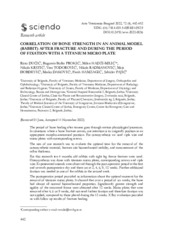Приказ основних података о документу
Correlation of bone strength in an animal model (rabbit) after fracture and during the period of fixation with a titanium micro plate
| dc.creator | Dučić, Risto | |
| dc.creator | Prokić, Bogomir Bolka | |
| dc.creator | Hadži-Milić, Milan | |
| dc.creator | Krstić, Nikola | |
| dc.creator | Todorović, Vera | |
| dc.creator | Radmanović, Nikola | |
| dc.creator | Đorđević, Maja | |
| dc.creator | Daković, Marko | |
| dc.creator | Hamzagić, Farah | |
| dc.creator | Pajić, Srbislav | |
| dc.date.accessioned | 2023-02-07T08:22:53Z | |
| dc.date.available | 2023-02-07T08:22:53Z | |
| dc.date.issued | 2022 | |
| dc.identifier.issn | 0567-8315 | |
| dc.identifier.uri | https://vet-erinar.vet.bg.ac.rs/handle/123456789/2525 | |
| dc.description.abstract | The period of bone healing after trauma goes through certain physiological processes. In situations where a bone fracture occurs, our intention is to surgically position in an appropriate morpho-anatomical position. For osteosynthesis we used vipla wire and micro plates with corresponding screws. The aim of our research was to evaluate the optimal time for the removal of the osteosynthetic material, fracture site biomechanical stability, and measurement of the callus thickness. For this research ten 4 months old rabbits with right leg femur fracture were used. Osteosynthesis was done with titanium micro plates, corresponding screws and vipla wire. Experimental animals were observed through the post-operative period at the first and seventh postoperative day and there on at 2, 4, 6, 9, 12 weeks. Further additional fixation was needed in one of the rabbits in the second week. The postoperative period provided us information about the optimal moment for the removal of titanium micro plates. It showed that over a period of six weeks, the bone had almost all normal biomechanical properties. Significantly greater strength and rigidity of the recovered femur were obtained after 12 weeks. Micro plates that were removed after 4, 6 or 9 weeks, did not need furhter fixation and therefore fixation was not applied, compared to those placed during the 12 weeks. X Ray evaluation provided us with follow up results of fracture healing. The results suggest that it is acceptable to remove titanium micro plates after a period of healing, that is, after the formation of the callus and bridging of the fracture gap and diastasis with newly formed bone. © 2022 Risto Dučić et al., published by Sciendo. | sr |
| dc.language.iso | en | sr |
| dc.publisher | Sciendo | sr |
| dc.relation | info:eu-repo/grantAgreement/MESTD/inst-2020/200143/RS// | sr |
| dc.relation | info:eu-repo/grantAgreement/MESTD/Integrated and Interdisciplinary Research (IIR or III)/45006/RS// | sr |
| dc.rights | openAccess | sr |
| dc.rights.uri | https://creativecommons.org/licenses/by/4.0/ | |
| dc.source | Acta Veterinaria | sr |
| dc.subject | rabbit | sr |
| dc.subject | femur | sr |
| dc.subject | osteotomy | sr |
| dc.subject | microplates | sr |
| dc.subject | bone strength | sr |
| dc.title | Correlation of bone strength in an animal model (rabbit) after fracture and during the period of fixation with a titanium micro plate | sr |
| dc.type | article | sr |
| dc.rights.license | BY | sr |
| dc.citation.volume | 72 | |
| dc.citation.issue | 4 | |
| dc.citation.spage | 442 | |
| dc.citation.epage | 452 | |
| dc.citation.rank | M23 | |
| dc.identifier.doi | https://doi.org/10.2478/acve-2022-0036 | |
| dc.identifier.fulltext | http://veterinar.vet.bg.ac.rs/bitstream/id/7294/bitstream_7294.pdf | |
| dc.type.version | publishedVersion | sr |

